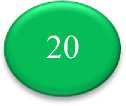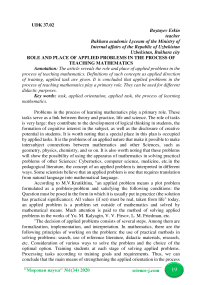Role and place of applied problems in the process of teaching mathematics
Автор: Boytayev Erkin
Журнал: Мировая наука @science-j
Рубрика: Основной раздел
Статья в выпуске: 1 (34), 2020 года.
Бесплатный доступ
The article reveals the role and place of applied problems in the process of teaching mathematics. Definitions of such concepts as applied direction of training, applied task are given. It is concluded that applied problems in the process of teaching mathematics play a primary role. They can be used for different didactic purposes.
Task, applied orientation, applied task, the process of learning mathematics
Короткий адрес: https://sciup.org/140264953
IDR: 140264953 | УДК: 37.02
Текст научной статьи Role and place of applied problems in the process of teaching mathematics
Problems in the process of learning mathematics play a primary role. These tasks serve as a link between theory and practice, life and science. The role of tasks is very large: they contribute to the development of logical thinking in students, the formation of cognitive interest in the subject, as well as the disclosure of creative potential in students. It is worth noting that a special place in this plan is occupied by applied tasks. It is the problems of an applied nature that make it possible to make intersubject connections between mathematics and other Sciences, such as geometry, physics, chemistry, and so on. It is also worth noting that these problems will show the possibility of using the apparatus of mathematics in solving practical problems of other Sciences: Cybernetics, computer science, medicine, etc.in the pedagogical literature, the concept of an applied problem is interpreted in different ways. Some scientists believe that an applied problem is one that requires translation from natural language into mathematical language.
According to M.V.Krutikhina, "an applied problem means a plot problem formulated as a problem-problem and satisfying the following conditions: the Question must be posed in the form in which it is usually put in practice (the solution has practical significance); All values (if set) must be real, taken from life" today, an applied problem is a problem set outside of mathematics and solved by mathematical means. Much attention is paid to the method of solving applied problems in the works of Yu. M. Kalyagin, V. V. Firsov, L. M. Friedman, etc.
"The decision of applied problems consists of several steps. Among them are formalization, implementation, and interpretation. In mathematics, there are the following principles of working on the problem: the use of practical methods in solving problems: search, use of reference literature, didactic materials, research, etc. Consideration of various ways to solve the problem and the choice of the optimal option. Training students at each stage of solving applied problems. Processing tasks according to training goals and requirements. Thus, we can conclude that the main means of strengthening the applied orientation in the process
of teaching mathematics are problems, but only under one condition, if these problems are correctly selected".
Today, we need to seriously work on the implementation of the applied orientation in the process of teaching mathematics, because the applied orientation of training contributes to the development of cognitive activity of students. To implement the applied orientation in the learning process, you need to go through a lot of examples, tasks, methods and training tools and choose the most optimal ones. Also, modern research shows that the introduction of computer technologies in the educational process can help to strengthen the applied orientation in the learning process. There are a number of requirements for applied problems in mathematics, but in addition to the main requirements, there are additional requirements: the availability of material; the cognitive value of applied problems for students; using real values and situations in problems.
Today, it is worth noting that interest in applied problems is increasing.
Applied problems in the process of teaching mathematics are of great importance. What is the place and role of applied problems in the school mathematics course? To answer this question, you must refer to their functions. Vinogradova L. V. in his book, he identifies three main functions of applied tasks:
The training function. The big advantage of this feature is that it can be used at all stages of a modern lesson.
Educational function. It contributes to the expansion of horizons, as well as the formation of a scientific worldview.
Developing function. It consists in the fact that applied tasks teach children to apply theoretical knowledge in practice. The role of applied problems in the process of teaching mathematics is huge. First of all, applied problems reveal all the variety of practical applications of mathematical knowledge. Also, the solution of applied problems helps to consolidate and deepen the previously studied theoretical material. Solving applied problems, we develop our memory, thinking, and attention.
Applied problems in the process of learning mathematics can be used for various didactic purposes:
Illustrations of educational material.
Formation of practical skills.
Motivation for learning.
The applied problem increases students ' interest in the subject being studied, because for most students, the value of mathematical education consists in its practical capabilities. Consolidation and deepening of previously acquired knowledge. To pose a problem before learning new material. The use of applied problems will ensure that students master the theory, teach students search techniques, thought operations, and so on. unfortunately, today, applied problems in the mathematics course are given too little time. According to E.V.Egupova, "the main reason for the low content of applied problems in General education textbooks is the complexity of selecting cases of using mathematics in a language that is understandable for students".

Currently, teachers do not devote much time to solving applied problems, because they believe that solving this type of problem takes too much time, and the training result is too small. Applied problems in the process of teaching mathematics should take a Central place. Students need to constantly train their ability to use the mathematical knowledge they have learned in the classroom in practice, in real life.
Therefore, at each lesson, students should be asked to solve problems with practical content. By solving such problems, students will increase their interest in the subject, increase their activity, and develop basic mathematical skills. Thus, we can conclude that applied problems in the process of learning mathematics occupy a Central place. The role of applied tasks is very large. They can be used for various didactic purposes: they can motivate, explain the connections of mathematics with other Sciences, and help students develop logical thinking, memory, and attention.
Список литературы Role and place of applied problems in the process of teaching mathematics
- Vinogradova L. V. Methods of teaching mathematics in high school: textbook / L. V. Vinogradov. - Rostov n/A: Phoenix, 2005. - 252 p.
- Шаходжаев, М. А., Бегматов, Э. М., Хамдамов, Н. Н., & Нўмонжонов, Ш. Д. У. (2019). ИСПОЛЬЗОВАНИЕ ИННОВАЦИОННЫХ ОБРАЗОВАТЕЛЬНЫХ ТЕХНОЛОГИЙ В РАЗВИТИИ ТВОРЧЕСКИХ СПОСОБНОСТЕЙ СТУДЕНТОВ. Проблемы современной науки и образования, (12-2 (145)).
- Xudoyberdiyeva, D. A. (2019). MANAGEMENT OF THE SERVICES SECTOR AND ITS CLASSIFICATION. Theoretical & Applied Science, (10), 656-658.
- Farxodjonova, N. (2019). FEATURES OF MODERNIZATION AND INTEGRATION OF NATIONAL CULTURE. Scientific Bulletin of Namangan State University, 1(2), 167-172.
- Фарходжонова, Н. Ф. (2016). Проблемы применения инновационных технологий в образовательном процессе на международном уровне. In Инновационные тенденции, социально-экономические и правовые проблемы взаимодействия в международном пространстве (pp. 58-61).


